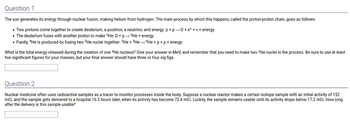
College Physics
11th Edition
ISBN: 9781305952300
Author: Raymond A. Serway, Chris Vuille
Publisher: Cengage Learning
expand_more
expand_more
format_list_bulleted
Concept explainers
Question

Transcribed Image Text:Question 1
The sun generates its energy through nuclear fusion, making helium from hydrogen. The main process by which this happens, called the proton-proton chain, goes as follows:
• Two protons come together to create deuterium, a positron, a neutrino, and energy: p + p→D+e++v+ energy
• The deuterium fuses with another proton to make ³He: D + p→→ ³He + energy
• Fianlly, 4He is produced by fusing two ³He nuclei together: ³He + 3 He→ 4He+p+p+ energy
What is the total energy released during the creation of one 4He nucleus? Give your answer in MeV, and remember that you need to make two ³He nuclei in the process. Be sure to use at least
five significant figures for your masses, but your final answer should have three or four sig figs.
Question 2
Nuclear medicine often uses radioactive samples as a tracer to monitor processes inside the body. Suppose a nuclear reactor makes a certain isotope sample with an initial activity of 152
mci, and the sample gets delviered to a hospital 16.5 hours later, when its activity has become 72.6 mCi. Luckily, the sample remains usable until its activity drops below 17.2 mCi. How long
after the delivery is this sample usable?
Expert Solution
This question has been solved!
Explore an expertly crafted, step-by-step solution for a thorough understanding of key concepts.
Step by stepSolved in 3 steps with 4 images

Knowledge Booster
Learn more about
Need a deep-dive on the concept behind this application? Look no further. Learn more about this topic, physics and related others by exploring similar questions and additional content below.Similar questions
- •12 The Aj particle and its products decay according to the scheme Aj - p° + n*, p° → T* + 7, et →et + v + ī, π-μ+ν u→e- + v + v. (a) What are the final stable decay products? From the evidence, (b) is the Aj particle a fermion or a boson and (c) is it a meson or a baryon? (d) What is its baryon number?arrow_forwardV6arrow_forwardEample: Ri= 4 Re 12v Rz = 3 R2 =6 Re 23 R2 Iッさェ, J。 ムv. AV2,2052 Iz, Ig AU, AVz AU, AU2,arrow_forward
- 6. The binding energy is the work that must be done to allow an object to escape to infinity. What is the binding energy for an object: a) on the surface of the earth b) in a circular orbit around the eartharrow_forwardQ7) The atomic nucleus uranium-235 has a spin of 2 h Estimate its speed!arrow_forward210- 84 X (atomic mass = 209.98285 u) undergoes a decay. Assuming all the released energy is in the form of kinetic energy of the a particle (atomic mass = 4.002603 u) and ignoring the recoil of the daughter nucleus (206X1 atomic mass = 205.97444 u), find the speed of the a particle. 82 Ignore relativistic effects. Number Unitsarrow_forward
- Two protons experience a head-on collision moving with velocity v. In order for there to be enough energy to create a new proton- antiproton pair, the velocity of each proton must equal? A) 2c B) 0.866c .914c D) 1.414carrow_forward1) For each of the following reactions work out the fastest interaction through which the conservation laws allow it to proceed. Explain your answers. If the reaction is forbidden by all interactions explain why: -+ a. pn++μ+ +μ¯ b. Aºp+e¯ c. μ΄ →e + V d. p+p→y+Y e. Kºn++ π + π° +7° f. π+pAº + Kº g. Aºn+p h. pnº+e+ + ve i. n→p+e+V₂arrow_forwardHS: Physics B [M] (Flex) - Activitie x C Chegg Search + → C A A psja0769-tstemhs-ccl.v3.gradpoint.com/student/27753139/activity/p 6 Atomic Learning 6 Content 360 6 DMAC O DMS (SLO input) 6 Destiny EVAAS 国 Quiz: Directions of the Processes HS: Physics B [M] (Flex) / 3:The Second Law of Thermodynamics 9. Which is an irreversible process? A spoonful of sugar dissolves in a cup of tea. A cup of iced tea is poured from a pitcher. A spoonful of sugar is scooped from a bowl. A spoon is tossed upward. HS: Physics B [M] (..arrow_forward
arrow_back_ios
arrow_forward_ios
Recommended textbooks for you
 College PhysicsPhysicsISBN:9781305952300Author:Raymond A. Serway, Chris VuillePublisher:Cengage Learning
College PhysicsPhysicsISBN:9781305952300Author:Raymond A. Serway, Chris VuillePublisher:Cengage Learning University Physics (14th Edition)PhysicsISBN:9780133969290Author:Hugh D. Young, Roger A. FreedmanPublisher:PEARSON
University Physics (14th Edition)PhysicsISBN:9780133969290Author:Hugh D. Young, Roger A. FreedmanPublisher:PEARSON Introduction To Quantum MechanicsPhysicsISBN:9781107189638Author:Griffiths, David J., Schroeter, Darrell F.Publisher:Cambridge University Press
Introduction To Quantum MechanicsPhysicsISBN:9781107189638Author:Griffiths, David J., Schroeter, Darrell F.Publisher:Cambridge University Press Physics for Scientists and EngineersPhysicsISBN:9781337553278Author:Raymond A. Serway, John W. JewettPublisher:Cengage Learning
Physics for Scientists and EngineersPhysicsISBN:9781337553278Author:Raymond A. Serway, John W. JewettPublisher:Cengage Learning Lecture- Tutorials for Introductory AstronomyPhysicsISBN:9780321820464Author:Edward E. Prather, Tim P. Slater, Jeff P. Adams, Gina BrissendenPublisher:Addison-Wesley
Lecture- Tutorials for Introductory AstronomyPhysicsISBN:9780321820464Author:Edward E. Prather, Tim P. Slater, Jeff P. Adams, Gina BrissendenPublisher:Addison-Wesley College Physics: A Strategic Approach (4th Editio...PhysicsISBN:9780134609034Author:Randall D. Knight (Professor Emeritus), Brian Jones, Stuart FieldPublisher:PEARSON
College Physics: A Strategic Approach (4th Editio...PhysicsISBN:9780134609034Author:Randall D. Knight (Professor Emeritus), Brian Jones, Stuart FieldPublisher:PEARSON

College Physics
Physics
ISBN:9781305952300
Author:Raymond A. Serway, Chris Vuille
Publisher:Cengage Learning

University Physics (14th Edition)
Physics
ISBN:9780133969290
Author:Hugh D. Young, Roger A. Freedman
Publisher:PEARSON

Introduction To Quantum Mechanics
Physics
ISBN:9781107189638
Author:Griffiths, David J., Schroeter, Darrell F.
Publisher:Cambridge University Press

Physics for Scientists and Engineers
Physics
ISBN:9781337553278
Author:Raymond A. Serway, John W. Jewett
Publisher:Cengage Learning

Lecture- Tutorials for Introductory Astronomy
Physics
ISBN:9780321820464
Author:Edward E. Prather, Tim P. Slater, Jeff P. Adams, Gina Brissenden
Publisher:Addison-Wesley

College Physics: A Strategic Approach (4th Editio...
Physics
ISBN:9780134609034
Author:Randall D. Knight (Professor Emeritus), Brian Jones, Stuart Field
Publisher:PEARSON